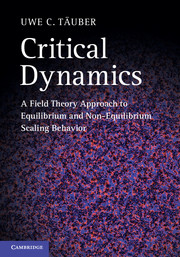Book contents
- Frontmatter
- Dedication
- Contents
- Preface
- Part I Near-equilibrium critical dynamics
- Part II Scale invariance in non-equilibrium systems
- 8 Non-equilibrium critical dynamics
- 9 Reaction-diffusion systems
- 10 Active to absorbing state transitions
- 11 Driven diffusive systems and growing interfaces
- Index
- References
10 - Active to absorbing state transitions
from Part II - Scale invariance in non-equilibrium systems
Published online by Cambridge University Press: 05 June 2014
- Frontmatter
- Dedication
- Contents
- Preface
- Part I Near-equilibrium critical dynamics
- Part II Scale invariance in non-equilibrium systems
- 8 Non-equilibrium critical dynamics
- 9 Reaction-diffusion systems
- 10 Active to absorbing state transitions
- 11 Driven diffusive systems and growing interfaces
- Index
- References
Summary
Continuous phase transitions from active to inactive, absorbing states represent prime examples of genuine non-equilibrium processes whose properties are strongly influenced by fluctuations. They arise in a broad variety of macroscopic phenomena, ranging from extinction thresholds in population dynamics and epidemic spreading models to certain diffusion-limited chemical reactions, and even turbulent kinetics in magnetic fluids. Intriguingly, the generic universality class for such active to absorbing phase transitions is intimately related to the scaling properties of critical directed percolation clusters. After elucidating this remarkable connection of stochastic kinetics with an originally geometric problem through mappings of both a specific microscopic interacting particle model and a more general mesoscopic Langevin description onto the corresponding Reggeon field theory action, we exploit the mathematical and conceptual techniques developed in previous chapters to compute the associated critical exponents to lowest non-trivial order in a dimensional ∊ expansion about the upper critical dimension dc = 4. We then set out to explore generalizations to systems with multiple particle species, and to investigate the dynamic percolation model variant that generates isotropic critical percolation clusters in the quasi-static limit. Particle spreading via long-range Lévy flights rather than nearest-neighbor hopping and coupling to an additional conserved field that may cause a fluctuation-induced first-order transition are also discussed. Motivated by the domain wall kinetics in non-equilibrium Ising systems, we address more general stochastic reaction systems of branching and annihilating random walks, and study the ensuing non-equilibrium phase diagrams and continuous transitions, including the parity-conserving universality class.
- Type
- Chapter
- Information
- Critical DynamicsA Field Theory Approach to Equilibrium and Non-Equilibrium Scaling Behavior, pp. 400 - 442Publisher: Cambridge University PressPrint publication year: 2014

